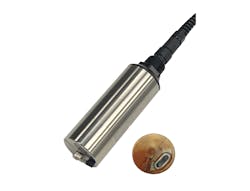Engineers at municipal water or wastewater facilities and industrial plants will find the new OIW80 Sensor from Electro-Chemical Devices (ECD) helps them quickly, accurately and economically detect oil in water leak incidents requiring fast response actions to prevent further contamination of drinking water, fouling of batch processes, damage to plant equipment and/or contamination of sensitive water ecosystems.
Oil in water is a serious issue for municipal drinking water and wastewater treatment. Engineers must monitor operations for oil contamination from storm water, oil pipeline leaks, refinery spills or other industrial plant accidents, etc. Oil leaks can affect surface water from streams, rivers or lakes, as well as ground water and water storage systems such as reservoirs and storage tanks.
Industrial plant engineers responsible for water-dependent processes, products and services also must worry about oil leaks. Industries vulnerable to oil-in-water contamination include: electric power, food/beverage, chemicals, electronics, pharmaceuticals and more. Oil-in-water leaks also can affects plant water re-use and effluent treatment processes prior to discharge.
The highly intelligent, precision OIW80 Sensor reliably measures oil in water over a range of 0 to 30 ppm (mg/L), and it can be factory preconfigured to measure oil in multiple ranges or easily set in the field. This rugged, high-performance responsive sensor operates over a temperature range from 41 to 113oF (5 to 45oC) to quickly detect leaks and alert plant technicians.
Designed for demanding and/or dirty plant environments, the highly dependable OIW80 Sensor features a built-in wiper cleaning system to remove bio solids and films that might cloud the sensor window’s visibility. The sensor features a built-in automatic screen window wiper that reduces technician manual checks and the frequency of scheduled maintenance cleanings.
The heavy-duty construction of the OIW80 Sensor’s rugged housing utilizes strong, corrosion resistant Stainless Steel (standard) or optional Titanium and meets the IP68 water ingress standard. Every aspect of the sensor’s design has been tailored for years of reliable operation and trouble-free service in the demanding wet environments typical of municipal and industrial water and wastewater treatment applications.
The versatile OIW80 Sensor features built-in RS485 serial communications and is Modbus/RTU compatible. Users can choose from ECD’s two-channel T80 Universal Transmitter or ECD’s eight-channel LQ800 Controller, or a wide range of RS485/Modbus compatible third-party controllers. Up to eight LQ800 Controllers can be networked to support large plant systems.
When the OIW80 Sensor is connected to the versatile ECD T80 Transmitter or the ECD LQ800 Controller, the sensor’s information is automatically uploaded to the analyzer. It then configures the displays and outputs of the transmitter to the values appropriate to the oil sensor’s measurement parameters. Its digital output communications are RS485/Modbus compatible
The universal T80 Transmitters are available as either single channel or dual channel devices, allowing one analyzer to measure up to two parameters or two ranges. This transmitter is available in a 24 VDC or a 100/240 VAC power configuration. All versions are available with an optional HART® output to support integration with larger control systems.
The highly scalable eight-channel LQ800 Multi-Channel Controller is designed to operate up to eight ECD digital analytical and process sensors. Its flexible design features Modbus communications, with optional HART, and is Cloud-ready allowing integration with larger systems. The LQ800 Controller is available as a 24 VDC or 100/240 VAC powered controller.
Editor's Note: Scranton Gillette Communications and the SGC Water Group are not liable for the accuracy, efficacy and validity of the claims made in this piece. The views expressed in this content do not reflect the position of the editorial teams of Water & Wastes Digest, Water Quality Products and Storm Water Solutions.
